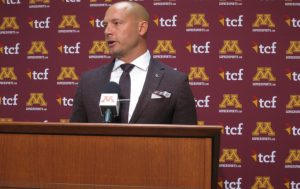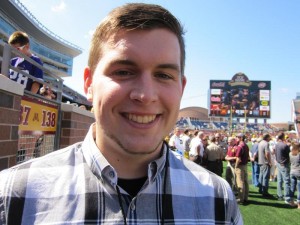The Golden Gophers football team closed fast the last several weeks winning three of their final four games including an upset and dominating performance against Georgia Tech last night in the Quick Lane Bowl in Detroit.

The victory gave Minnesota a final record above .500 at 7-6. The game offered more evidence the players are all-in on head coach P.J. Fleck and his culture. His “Row the Boat” mantra and demanding high energy environment has generated critics among the public, media and even presumably inside the halls of the U athletics compound, but it appears the second-year head coach has won over his team and perhaps placed the program on a path of sustained success.
In surprise wins, Minnesota has defeated Purdue, 41-10, Wisconsin, 37-15 and Georgia Tech, 34-10. Those are three above average Power Five teams, and people who know football are noticing including a former prominent Minnesota high school coach who has been following the Gophers for decades.
“I think the players have bought in,” he said last night, while speaking anonymously. “There’s been a lot of criticism of Fleck, and the players hear that, but now they believe. The culture has changed.”
Another football authority, who also didn’t want his name used, agreed that Minnesota’s impressive late season rally from a poor record going into the Purdue game on November 10 is significant. “It gives hope that the program is going in the right direction,” he said.
The Gophers’ overall record before the Purdue game was 4-5 and they were 1-5 against Big Ten opponents. Minnesota finished the regular season with records of 6-6 and 3-6.
Minnesota’s performance last night can only be graded as excellent work by both coaches and players. The Gophers were prepared and they executed their plans including defensively against a Tech team that was leading the nation in rushing at almost 335 yards per game.
GT’s triple-option attack can make defenders look like traffic cones. A story by college football media authority Athlon before the game said, “Georgia Tech’s offense is nearly impossible to stop, much less slow down.”
The Gophers started the game by making Tech go three-and-out on its first two possessions. Coach Paul Johnson’s team was held to 224 yards rushing by playing assignment football and doing it with passion. The effort was part of a resurgence by a Minnesota defense that held Purdue, Wisconsin and Georgia Tech to an average of 11.7 points per game.
That success came after a period when the Gophers gave up 30 points or more to six opponents, and yielded over 40 points four times. The disaster of allowing lowly Illinois to score 55 points forced a change in defensive coordinators and philosophy—mainly making defensive assignments simpler under the direction of new leader Joe Rossi. “When kids can play fast, they can have that kind of success, thinking less and reacting faster,” one of the sources said. “Simplifying things made all the difference and allowed the players to play with a lot of confidence.”
The Gopher offense did its part in the Quick Lane Bowl win, too. Minnesota scored 13 points in the first half and 21 in the second with multiple players at their best including freshman running back Mohamed Ibrahim who ran for 224 yards. Ibrahim’s exceptional vision enables him to find running lanes and his determination to not be tackled to the ground is in the best tradition of recent Gopher running backs.
Junior wide receiver Tyler Johnson had two touchdown catches last night and is likely weighing a decision to turn pro. He might project as a mid-round NFL draft pick in a few months but could decide another season would benefit his draft status more in 2020. He was named first team All-Big Ten by the media after the regular season when his 74 catches ranked second in the conference.
Freshman quarterback Tanner Morgan managed the offense impressively, not only throwing two touchdown passes but by not turning the ball over. It might have been Morgan’s best game after becoming the starter last month.
What caught the attention of observers as much as anything last night was how physical the Minnesota offense was. The unit looked bigger and stronger than GT’s defensive players, with the Gophers coming up with 403 yards in total offense to their opponent’s 301. “The offensive line was fantastic,” one of the sources said.
Minnesota behemoths including Blaise Andries, Curtis Dunlap Jr. and Daniel Faalele often pushed adversaries around using superior physical size and technique. At 6-foot-9 and 400-pounds Faalele is difficult to miss. The authority quoted in the previous paragraph said Faalele has big time potential and can become stronger. “I think he’s a Sunday (NFL) player,” he said.
The Gophers earned considerable success last night despite not having many players who have been starters, and even high impact performers. Defensively Minnesota was without Antoine Winfield, Jr., Blake Cashman, Kamal Martin, O.J. Smith and Jamaal Teague. On offense the Gophers didn’t have Donnell Greene, Shannon Brooks and Rodney Smith.
The win is an indication of developing depth on the roster. That means there will be a lot of competition for starting positions going into spring practice and fall camp just before next season’s 12-game schedule. This competition will come despite most of the roster’s starters returning next season and being joined by an impressive freshman class.
The way the program closed out 2018 also means something else, according to one of the authorities. “The biggest thing is it gives you great confidence going into the offseason,” he said.
The Gophers have now played in 12 bowl games in program history. The greatest of victories include a Rose Bowl win and last second victory over Oregon. There is also a win over Alabama when that football factory was at ‘low tide.” Ranking near the top of any bowl list was Minnesota’s win two years ago against pass-happy and favored Washington State when Gopher coach Tracy Claeys designed a marvelous defense to help his suspension riddled team win the Holiday Bowl.
Is it likely that some day historians may look back and view the 2018 Quick Lane Bowl win by Minnesota as part of a new chapter of success for a program that hasn’t won a Big Ten title since 1967?
Comments Welcome




